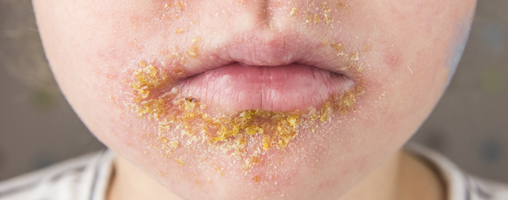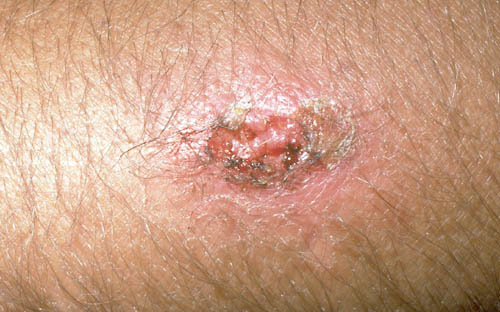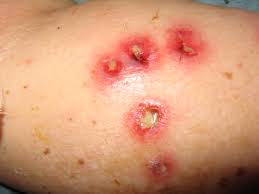
What is impetigo?
- Impetigo is a superficial skin infection that may develop on normal skin or may complicate eczema (impetiginized eczema).
- Crusted impetigo (impetigo contagiosa) is caused by S. aureus, Streptococcus pyogenes, or a combination of both.
- Bullous impetigo is mediated by epidermolytic toxins (ET) released by phage group II S. aureus. Toxins disrupt adhesion between keratinocytes in the superficial epidermis within an area of infection by cleaving a specific desmosomal cadherin, desmoglein 1. This enables S. aureus to penetrate the skin barrier, proliferate, and spread under the stratum corneum.
- Factors that predispose to impetigo include minor trauma, including insect bites, eczema, head lice, hot climates, crowded living conditions, poor hygiene, and immunodeficiency.

What should I look for?
- One or more areas of golden, honey-coloured crusting and oozing.
- Thin-walled, flaccid blisters that rupture rapidly, because epidermal cleavage is superficial, just below the stratum corneum.
- Patients with localized impetigo do not have systemic symptoms.
- Several members of the family may be affected.
What should I do?
- Take skin swabs from crusted skin for culture (in SSSS, swabs from the erythema and blisters will be sterile, as the signs are caused by the circulating toxin, and not local infection).
- A topical antibiotic, such as fusidic acid or mupirocin, is sufficient in patients with a small focus of infection. In more widespread or recurrent infections, prescribe an oral antibiotic such as flucloxacillin or erythromycin—alter according to sensitivities.
- The focus of infection in SSSS should be treated with an oral antibiotic.
- Antiseptic wash may be helpful in patients with recurrent impetigo.
Toxin-mediated diseases
- SSSS (Ritter disease) presents in neonates, young children, adults with renal failure, and the immunosuppressed. patients have a focus of impetigo caused by the strain of Staphylococcus that releases epidermolytic toxins. This focus may not be apparent. The circulating ET cause widespread erythema and superficial blistering.
- TSS is a multisystem disease caused by an exotoxin produced most often by S. aureus. TSS may be mild or rapidly fatal.
What is ecthyma?
- A deeper infection than impetigo that is caused by S. pyogenes or, less often, S. aureus.
- Commoner in the malnourished or immunosuppressed.
- Seen most often on the legs and usually preceded by a minor injury or insect bite.
- Starts as a blister with an erythematous border (‘deep impetigo’) but develops into a well-circumscribed ‘punched-out’ ulcer involving the full thickness of the epidermis. May enlarge to a diameter of 2–3cm, if untreated. only a few lesions. heals slowly with scarring.
- Systemic symptoms are uncommon.

What should I do?
- Take skin swabs for culture, and treat with oral antibiotics, e.g. flucloxacillin.
What is ecthyma gangrenosum?
- This infection caused by P. aeruginosa is associated with debility and immunosuppression. Ecthyma gangrenosum is usually a manifestation of Pseudomonas septicaemia. It may not be possible to demonstrate a bacteraemia in the anogenital form in immunocompromised patients when Pseudomonas may enter the skin through a wound or hair follicle.
- Starts as a painless erythematous or purpuric macule on limbs or anogenital skin. Develops into a nodule with a central haemorrhagic vesicle that breaks down to form a large necrotic ulcer with a central dark eschar and an inflamed border. Several lesions may be present.
- Mortality is 10–20%.
- Differential includes PG, necrotizing vasculitis, cryoglobulinaemia, and septic emboli from other organisms.
What should I do?
- Take a skin biopsy for histology and culture
- Culture blood and urine.
- Treat with IV antibiotics.